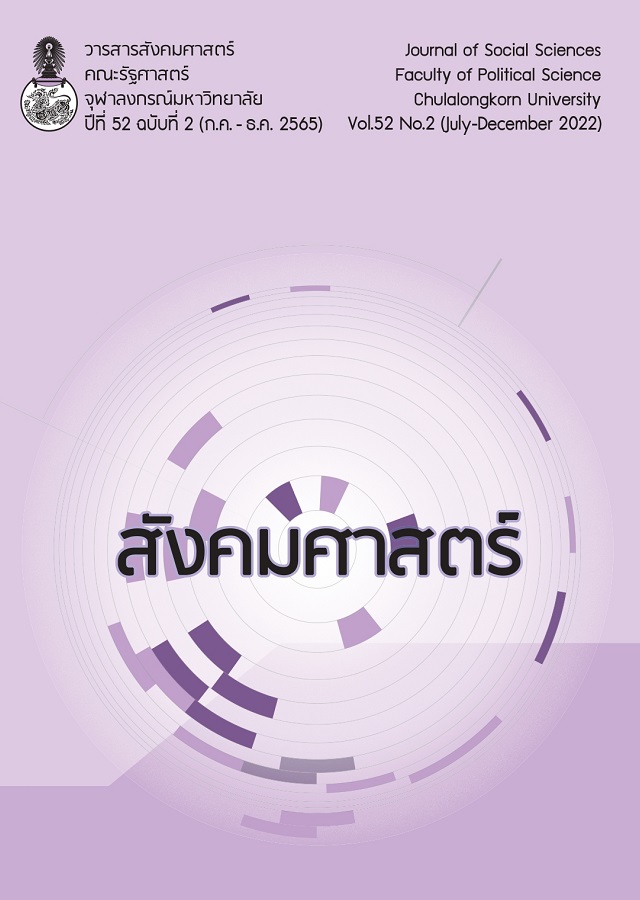วัฒนธรรมสร้างสรรค์ขององค์การสมองซีกขวาที่นำไปสู่การสร้างนวัตกรรมองค์การระดับโลก: ศึกษากรณี วัดร่องขุ่น จังหวัดเชียงราย ประเทศไทย
DOI:
https://doi.org/10.61462/cujss.v52i2.911คำสำคัญ:
วัฒนธรรมสร้างสรรค์, องค์การสมองซีกขวา, การบริหารวัฒนธรรมองค์การ, การสร้างวัฒนธรรมองค์การบทคัดย่อ
วัฒนธรรมสร้างสรรค์ขององค์การสมองซีกขวาซึ่งเป็นองค์การที่มีศักยภาพในการทำหน้าที่ของสมองซีกขวาในการผลิตจินตนาการนั้น เป็นหัวใจสำคัญในการสร้างนวัตกรรมองค์การระดับโลก อาทิ มหาวิหาร ซากราดา ฟามิเลีย บทความนี้มีวัตถุประสงค์เพื่อศึกษาลักษณะการบริหารวัฒนธรรมองค์การ ของวัดร่องขุ่น จังหวัดเชียงราย ว่าได้อาศัยวัฒนธรรมสร้างสรรค์ขององค์การสมองซีกขวาหรือไม่ อย่างไร ในการสร้างนวัตกรรมองค์การ และศึกษามาตรการเพื่อส่งเสริมและประยุกต์ใช้กับองค์การภาครัฐ โดยอาศัยการบูรณาการข้ามศาสตร์ ด้วยวิธีวิจัยแบบผสม ทั้งเชิงปริมาณและคุณภาพ เครื่องมือในการวิจัย ได้แก่ แบบสอบถาม แบบสัมภาษณ์กึ่งโครงสร้าง และแบบสัมภาษณ์เชิงลึก กลุ่มตัวอย่าง ได้แก่ กลุ่มผู้ที่ปฎิบัติงานในวัดร่องขุ่น กลุ่มผู้เชี่ยวชาญสาขาต่าง ๆ และกลุ่มสาธารณชน ข้อค้นพบคือ (1) การบริหารวัฒนธรรมองค์การของวัดร่องขุ่น ได้อาศัยวัฒนธรรมสร้างสรรค์ขององค์การสมองซีกขวาทุกมิติ ข้อมูลจากแบบสอบถามแสดงว่ากลุ่มตัวอย่างมีการรับรู้วัฒนธรรมสร้างสรรค์ ลักษณะองค์การสมองซีกขวา และการสร้างนวัตกรรมของวัดร่องขุ่น อยู่ในระดับสูงที่สุด สอดคล้องกับผลการสัมภาษณ์และข้อเสนอทางทฤษฎี (2) มาตรการส่งเสริมและประยุกต์ใช้การบริหารด้วยแนวทางวัฒนธรรมสร้างสรรรค์ขององค์การสมองซีกขวา เพื่อสร้างนวัตกรรมขององค์การภาครัฐ ได้แก่ การส่งเสริมวัฒนธรรมเชิงรุกและวัฒนธรรมมืออาชีพ การขจัดวัฒนธรรมความกลัวและวัฒนธรรมการลอกเลียนแบบ
Downloads
เอกสารอ้างอิง
Burry, Mark. 1993. Expiatory Church of the Sagrada Familia: Antoni Gaudi. London: Phaidon.
Chalermchai Kositpipat. 2006. Sang Phutthasin Phuea Phaendin. [Creating Buddhist Art for the Country]. Bangkok: Amarin. (in Thai)
Cooke, Robert A., and J. Clayton Lafferty. 1989. Organizational Culture Inventory. Plymouth, MI: Human Synergistics.
Damanpour, Fariborz. 1987. “The Adoption of Technological, Administrative, and Ancillary Innovations: Impact of Organizational Factors.” Journal of Management 13(4): 675-688.
Drucker, Peter F. 1993. Post-Capitalist Society. Oxford: Butterworth-Heineman.
Evan, William. 1966. “Organizational Lag.” Human Organization 25(1): 51-53.
Finke, Ronald A., Thomas B. Ward, and Steve M. Smith. 1992. Creative Cognition: Theory, Research, and Applications. Cambridge, MA: MIT Press.
Fromm, Erich. 1987. The Art of Loving. London: Unwin Paper-backs.
Gardner, Howard E. 1993. Creating Minds: An Anatomy of Creativity Seen through the Lives of Freud, Einstein, Picasso, Stravinsky, Eliot, Graham, and Gandhi. New York: Basic Book.
Gelb, Michael J. 2002. Discover Your Genius: How to Think Like History's Ten Most Revolutionary Minds. New York: Harper Collins.
Hamel, Gary, and C.K. Prahalad. 1994. Competing for the Future. Boston, MA: Harvard Business School Press.
Handy, Charles B. 1999. The New Alchemists. London: Hutchinson.
Harkema, Saskia. 2003. “A Complex Adaptive Perspective on Learning within Innovation Projects.” The Learning Organization 10(6): 340-346.
Hassapop Tangmahamek. 2013. Sinlapa Thai Ruam Samai: Chalermchai Kositpipat. [Thai Contemporary Art: Chalermchai Kositpipat]. Bangkok: Amarin. (in Thai)
Hermann, Ned. 1996. The Whole Brain Business Book. New York: McGraw-Hill.
Hood, Christopher. 1991. “A Public Management for All Seasons?” Public Administration 69(1): 19.
Juthamard Intararumpun. 2009. “Naeo Khwamkhit Rueang Traiphum Thi Sathon Nai Ngan Sinlapa Lae Sathapattayakam Wat Rong Khun Changwat Chiang Rai.” [The Concept of Tri Phumi as Reflected in the Art and Architecture of Wat Rong Khun, Chiang Rai].” Master’s thesis, Faculty of Art History, Silpakorn University. (in Thai)
Kotter, John P. 1996. Leading Change. Boston, MA: Harvard Business School Press.
Morgan, Gareth. 1989. Creative Organization Theory: A Resource Book. Newbury Park, London: Sage.
-----. 2006. Images of Organization. Thousand Oaks, CA: Sage.
Osho. 1999. Creativity: Unleashing the Forces Within. New York: St. Martin's Griffin.
Perez-Bustamante, Guillermo. 1999. “Knowledge Management in Agile Innovative Organizations.” Journal of Knowledge Management 3(1): 6-17.
Perkins, David N., and Gavriel Salomon. 1992. “Transfer of Learning.” In International Encyclopedia of Education. Oxford: Pergamon Press.
Pfenninger, Karl H., and Valerie R. Shubik, eds. 2001. The Origins of Creativity. Oxford: Oxford University Press.
Pink, Daniel H. 2005. A Whole New Mind. New York: Riverhead Books.
Porter, Michael. E. 1980. Competitive Strategy: Techniques for Analyzing Industries and Competitors. New York: Free Press.
Rosenbloom, David H., and Robert S. Kravchuk. 2002. Public Administration: Understanding Management, Politics, and Law in the Public Sector. Singapore: McGraw-Hill International.
Schilling, Melissa A. 2008. Strategic Management of Technological Innovation. New York, NY: McGraw-Hill Education.
Smits, Ruud. 2002. “Innovation Studies in the 21st Century: Questions from a User’s Perspective.” Technological Forecasting and Social Change 69(9): 861-883.
Sperry, Roger W. 1950. “Neural Basis of the Spontaneous Optokinetic Response Produced by Visual Inversion.” Journal of Comparative and Physiological Psychology 43(6): 482-489.
Tushman, Michael L., and David A. Nadler. 1986. “Organizing for Innovation.” California Management Review 28(3): 74-92.
Utterback, James M. 2004. “The Dynamics of Innovation.” Educause Review 39(1): 42-51.
Von Oech, Roger. 1986. A Kick in the Seat of the Pants: Using Your Explorer, Artist, Judge, and Warrior to Be More Creative. New York: Harper and Row.
ดาวน์โหลด
เผยแพร่แล้ว
รูปแบบการอ้างอิง
ฉบับ
ประเภทบทความ
สัญญาอนุญาต
ลิขสิทธิ์ (c) 2022 คณะรัฐศาสตร์ จุฬาลงกรณ์มหาวิทยาลัย

อนุญาตภายใต้เงื่อนไข Creative Commons Attribution-NonCommercial-NoDerivatives 4.0 International License.
เงื่อนไขการอนุญาตสาธารณะ
นโยบายลิขสิทธิ์และการอนุญาต
วารสารสังคมศาสตร์ จุฬาลงกรณ์มหาวิทยาลัย เผยแพร่เนื้อหาทั้งหมดภายใต้ สัญญาอนุญาตครีเอทีฟคอมมอนส์แบบแสดงที่มา-ไม่ใช้เพื่อการค้า-ไม่ดัดแปลง 4.0 นานาชาติ (CC BY-NC-ND 4.0)
ลิขสิทธิ์
บทความทั้งหมดที่ตีพิมพ์ในวารสารสังคมศาสตร์ จุฬาลงกรณ์มหาวิทยาลัย เป็นลิขสิทธิ์ของ คณะรัฐศาสตร์ จุฬาลงกรณ์มหาวิทยาลัย ผู้เขียนจะโอนสิทธิ์ทั้งหมดให้แก่วารสารเมื่อบทความได้รับการตอบรับให้ตีพิมพ์
สัญญาอนุญาต CC BY-NC-ND 4.0
ภายใต้สัญญาอนุญาตนี้:
-
แสดงที่มา (BY): ผู้ใช้ต้องแสดงที่มาโดยอ้างอิงถึงผู้เขียน คณะรัฐศาสตร์ จุฬาลงกรณ์มหาวิทยาลัย และวารสารสังคมศาสตร์ จุฬาลงกรณ์มหาวิทยาลัย พร้อมทั้งให้ลิงก์ไปยังสัญญาอนุญาต และระบุหากมีการเปลี่ยนแปลง ทั้งนี้สามารถทำได้ในลักษณะที่สมเหตุสมผล แต่ต้องไม่ทำในลักษณะที่แสดงว่าผู้อนุญาตให้การรับรองผู้ใช้หรือการใช้งานดังกล่าว
-
ไม่ใช้เพื่อการค้า (NC): ผู้ใช้ไม่สามารถใช้เนื้อหาเพื่อวัตถุประสงค์ทางการค้า การใช้งานเชิงพาณิชย์จะต้องได้รับอนุญาตเป็นลายลักษณ์อักษรล่วงหน้าจากผู้เขียนและคณะรัฐศาสตร์ จุฬาลงกรณ์มหาวิทยาลัย
-
ไม่ดัดแปลง (ND): หากผู้ใช้นำเนื้อหาไปรวม ดัดแปลง หรือต่อยอด ผู้ใช้ไม่สามารถเผยแพร่งานที่ดัดแปลงนั้นได้ การดัดแปลงผลงานจะต้องได้รับอนุญาตเป็นลายลักษณ์อักษรล่วงหน้าจากผู้เขียนและคณะรัฐศาสตร์ จุฬาลงกรณ์มหาวิทยาลัย
นโยบายการเข้าถึงแบบเปิด
วารสารสังคมศาสตร์ จุฬาลงกรณ์มหาวิทยาลัย ให้การเข้าถึงเนื้อหาแบบเปิดโดยทันทีตามหลักการที่ว่าการทำให้งานวิจัยสามารถเข้าถึงได้อย่างเสรีแก่สาธารณะจะสนับสนุนการแลกเปลี่ยนความรู้ในระดับโลก ผู้ใช้สามารถอ่าน ดาวน์โหลด คัดลอก เผยแพร่ พิมพ์ ค้นหา หรือเชื่อมโยงไปยังเนื้อหาฉบับเต็มของบทความได้โดยไม่ต้องขออนุญาตล่วงหน้าจากผู้จัดพิมพ์หรือผู้เขียน ทั้งนี้เป็นไปตามสัญญาอนุญาต CC BY-NC-ND 4.0
นโยบายการเก็บบันทึกด้วยตนเอง
ผู้เขียนสามารถเก็บบันทึกบทความฉบับตีพิมพ์สุดท้าย ต้นฉบับที่ส่ง (preprint) หรือฉบับที่ผ่านการประเมิน (postprint) ในคลังสถาบันหรือเว็บไซต์ส่วนตัวได้ โดยต้องมีการอ้างอิงการตีพิมพ์ครั้งแรกในวารสารสังคมศาสตร์ จุฬาลงกรณ์มหาวิทยาลัย พร้อมระบุแหล่งอ้างอิงที่สมบูรณ์และลิงก์ไปยังเว็บไซต์ของวารสาร
การขออนุญาต
สำหรับการใช้งานนอกเหนือจากที่ครอบคลุมโดยสัญญาอนุญาต CC BY-NC-ND 4.0 กรุณาติดต่อ:
กองบรรณาธิการ
วารสารสังคมศาสตร์ จุฬาลงกรณ์มหาวิทยาลัย
คณะรัฐศาสตร์ จุฬาลงกรณ์มหาวิทยาลัย
Email: cusocscij@gmail.com
สำหรับข้อมูลเพิ่มเติมเกี่ยวกับสัญญาอนุญาตครีเอทีฟคอมมอนส์แบบแสดงที่มา-ไม่ใช้เพื่อการค้า-ไม่ดัดแปลง 4.0 นานาชาติ กรุณาเยี่ยมชม: https://creativecommons.org/licenses/by-nc-nd/4.0/deed.th





